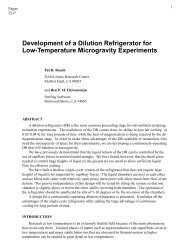cdms-ii - CDMS Experiment - University of California, Berkeley
cdms-ii - CDMS Experiment - University of California, Berkeley
cdms-ii - CDMS Experiment - University of California, Berkeley
You also want an ePaper? Increase the reach of your titles
YUMPU automatically turns print PDFs into web optimized ePapers that Google loves.
1.3. DIRECT DETECTION OF DARK MATTER 23<br />
<strong>CDMS</strong> II - SUF<br />
The <strong>CDMS</strong> collaboration has developed another detector technology for dark matter<br />
detection. The detectors are crystals <strong>of</strong> Ge and Si with sensors that simultaneously<br />
measure the ionization and athermal phonons produced by a recoil. These detectors<br />
are described in more detail in Ch. 2. They are capable <strong>of</strong> discrimination due to the<br />
reduced ionization for a nuclear recoil. The detectors are designed to also measure<br />
timing information from the athermal phonon signal making it possible to reconstruct<br />
the location <strong>of</strong> the interaction. The ability to reconstruct the position <strong>of</strong> an event<br />
enables the rejection <strong>of</strong> the background from electron recoils near the surface. The<br />
use <strong>of</strong> both Si and Ge detectors allows for an estimate <strong>of</strong> neutron backgrounds since<br />
the cross section for neutrons in Si is 5-7 times larger in Si than in Ge. The <strong>CDMS</strong><br />
II experiment [42] observes no dark matter detection at the Stanford Underground<br />
Facility. The sensitivity was again limited by the irreducible neutron background.




